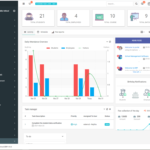
How to Spend the Pandemic Time Effectively to Studies
June 26, 2021
Click with School Management Software to a Highly Demanded Education
July 25, 2021The educational industry has been stepped a long way for many years. Though we learned using only textbooks and materials, now children have many types of equipment and tools for the learning process. They always connect with the tools and the technology is powering them for a better future with a good job market.
Cloud computing is a rising concept in the educational niche.it has very valuable uses to attract users. Some of them are Infrastructure as a service (Iaas) / platform as a service (Paas) /software as a service (Saas), hybrid cloud and multi-cloud, test and development, big data analytics, cloud storage, disaster recovery, data backup, etc.
Cloud computing technology supplies user access to storage, files, software, and services through their internet-connected devices such as computers, tablets, smartphones, etc. Cloud computing provides the ability to store and access data and programs over the internet instead of on a hard drive.
Top cloud computing technologies
- Virtualization
- Hardware virtualization
- Operating system virtualization
- Server virtualization
- Storage virtualization
- Service-oriented architecture
- Grid computing
- Utility computing
Cloud computing is a source, which we can share anywhere, without worrying about the user’s location. When activating cloud computing you get the ability to collaborate with instructors and learners on the same platform. Then, the schools, campus, universities do not want to buy or maintain their servers, databases. Instead of them, they can use cloud computing to store databases and other services. Otherwise, they can be satisfied with their sources’ security. There are lots of benefits of cloud computing in an educational niche.
- The strong virtual classroom environment: There is virtual class rooms depend on cloud computing-based software. This concept less the cost for infrastructural facilities. It can lessen the cost of teachers’ transport cost also. Instead of they can follow the distance working by collaborating clever coaches/teachers. And also gives the facility to teachers to create online courses for students been anywhere. Then students can save their time and spend them on their exams.
- Ease of accessibility: The potential for Cloud computing access is unlimited. Users can access the course content, applications, data easily anywhere, anytime. They can enter for courses and also for group activities. Anymore no barriers for time and place. Cloud computing certifies sharing without barriers. Not only that it can send via mobile phones, and then students can use them while traveling on the way.
- Extensive cost savings: Another valuable advantage in cloud computing is, wide cost savings. in this section, the learners and suppliers can benefit a lot. Students do not want to spend on expensive books and materials as they all available in cloud computing. The suppliers can less the cost by simplifying the registration process and assignment process. The fractional cost also becomes less. The most valuable one is paying when you go. Then it is beneficial.
- Secure data storage: Cloud computing does a better service for secure data storage. the institution which allows students to learn via cloud computing can use VPN for certifying data protection.IKEv2 and VPN protocols must be responsible for outgoing data and traffic. This means that users can easily change the learning content without destroying its continuing. And also student can protect their privacy by using VPN for educational applications.
- Scalability: The application can match the growing numbers of users.in this section, schools, colleges, and universities are covered by cloud computing.it gives them the ability to scale learning applications and experiences easily. As a result, they can conduct the increasing count of students. And also the scale helps them to manage the traffic due to usage of registration and assignment presenting. And they can use the scale in a short activity time for preventing source wasting.
- Agility and innovation: Another way to get advantages for users from cloud computing is active and modification.it gives them the ability to experiment fast and frequently. as a result, they can modify this to supply better learning progress. How they can do is, by developing, examine, using new tools in applications.
- Greater reach for the students: With cloud computing children can spread their limits in the educational sector. Those who become not satisfied with traditional learning can follow observe online education and that concept. This is marvelous for students who like distance learning and who like to follow abroad courses. This is important for employees who are willing to polish and upgrade their skills but, unable to attend traditional classrooms
- Minimum hardware requirements: The requirements for hardware become minimum with the applications based on cloud computing. These applications can run on internet browsers, desktops, and mobile equipment students can learn, manage with their smartphone. Do not need to invest in an expensive computer.no need for external storage tools as they get free access to cloud computing stores.
- Examples of the application of cloud technologies in education: Google classroom, blackboard, knowledge matters, courser, Microsoft education center, class flow
The benefits for the educational sector from cloud computing are immersive.it is not a surprise the suppliers warmly welcome cloud computing. As then they can develop their services. And also cloud computing is rising as the best option among students. Cloud computing lets the students access through the finger. Cloud symbol is a metaphor for the internet.
Anything has two sides good and bad; there are advantages as well as disadvantages. There are specific points you must consider when turning into cloud computing.
- Cloud security and data: You must consider Storing data and keeping files in virtual data centers because they can make you a risk. Common risks are,
- Your data can be lost or theft
- Data leakage can be occurring. Account or service hijacking
- Insecure interfaces and APIs
- Denial of service attacks can be occur
- There can be technology vulnerabilities especially in shared environments
- Cloud downtimes: There can be technical problems like other IT setups. Reboots, network outages, and downtimes are some examples. So you have to make a plan for downtime before using.
- Limited control: You can only manage applications, data, and services. You are unable to access key administrative task like updating and managing firmware




